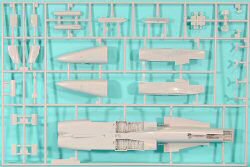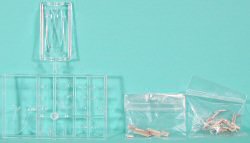
Hasegawa 1/48 F/A-18C Hornet Kit First Look
By Michael Benolkin
| Date of Review | March 2007 | Manufacturer | Hasegawa |
|---|---|---|---|
| Subject | F/A-18C Hornet | Scale | 1/48 |
| Kit Number | 07083 | Primary Media | Styrene, Photo Etch |
| Pros | Best Hornet kit in 1/48 scale | Cons | Minor fit and fragile challenges require patience and some skills |
| Skill Level | Experienced | MSRP (USD) | Out of Production |
First Look
 |
 |
 |
 |
 |
 |
 |
The history of the F/A-18 Hornet program is colorful to say the least. After recovering from the financial and schedule impacts from the mandated F-111B program and gaining the most capable fleet defense fighters in history with the resulting F-14 Tomcat, the Navy was still faced with replacing the F-4s on those carriers that were not capable of operating the F-14 as well as replace the fleet of A-7E Corsair II strike aircraft.
The Air Force was in full swing with its lightweight fighter program that pitted the General Dynamics YF-16 against the Northrop YF-17. The Navy was considering a purchase of the same type that won the Air Force's competition, but when the YF-16 was declared the winner, the Navy had second thoughts. The YF-16 had some inherent problems at the time, not the least of which was only one engine. The Navy decided to base their next fighter on the YF-17 Cobra.
During the acquisition process for this new aircraft, somehow McDonnell Douglas was selected to convert the YF-17 into a carrier-capable lightweight fighter while Northrop became a subcontractor to support their design. The conversion process turned out to be more difficult as time progressed as the Navy added requirements to the aircraft and these requirements translated into additional weight and cost. The resulting airframe was quite different from the original YF-17 and nearly 7,000 pounds heavier at empty weight.
The F/A-18C was an incremental improvement over the F/A-18A with upgraded engines, radar, weapons, the NACES ejection seat, and other avionics. While the F/A-18B was a two-seat trainer variant of the Hornet, the F/A-18D was enhanced to fulfill the night attack mission and replace the A-6 Intruder after that type's original replacement, the A-12 Avenger II failed to enter production.
Hasegawa has made some wise investments in kit tooling over the past few decades. The F-4 Phantom II series and the F-14 Tomcats continue to sell as Hasegawa continued to turn out reissues of each variant with different decals. The F-14 was a super-detailer's dream and fortunately Hasegawa applied that kit design philosophy with their family of F/A-18 Hornets.
The upper fuselage is molded in one part with the upper wing halves molded in-place. This makes the job of assembly and alignment SO much easier. The rest of the kit is presented on five parts trees (duplicate trees not shown) plus a single tree of clear parts. The details on the surface of the model are finely scribed and pre-date the current trend of over-emphasized recessed rivet details.
The mold is set up to support two-seat Hornets. The cockpit tub is a two-holer where the rear pit is merely covered over with a plug and canopy fairing. The design of this kit is quite impressive which allowed Hasegawa to render all the different variants of the 'Bug' with minimal differences in parts.
The variants produced of this family include:
- F/A-18A
- F/A-18B
- F/A-18C
- F/A-18D
- CF-18A/CF-188A
- CF-18B/CF-188B
In addition, several versions of this kit were released in their 'Hi-Grade' series including this one - Chippy-Ho. This kit was released in 1999 and was one of the few that offered white metal landing gear AND white metal wing folds.
Even with the white metal parts, assembly of this kit is not difficult for the patient modeler. You have the options of positionable canopy, positionable stabilators, positionable leading and trailing edge flaps, positionable rudders, positionable ailerons, and positionable speed brakes. You can skip the white metal landing gear and position the gear up, or you can use the white metal wing fold mechanisms to position the outer wing panels folded. Decisions, decisions.
One of the shortfalls of this series of kits is armament. Hasegawa adopted the philosophy of selling their weapons sets separately, so if you want to bomb up your Hornet, you'll need to buy the Hasegawa (or other aftermarket) weapons set(s). The kit does include the VER - the Vertical Ejector Racks to allow two 500lb bombs to be carried under a single pylon. The kit also includes a pair of underwing external tanks.
Hasegawa provides markings in this release for two VFA-195 Dambusters aircraft as they appeared in the late 1990s out of NAS Atsugi and as part of CVW-5 aboard the USS Midway. The CAG aircraft (Modex 400) wears the special Chippy Ho! colors while markings are also provided for the squadron commander (Modex 401).
Hasegawa continues to do a nice job with the F/A-18 series and have more recently released the next generation Super Hornet kits as well. Patience, dry-fitting, and some trimming will be required to get all of the parts to come together. Nevertheless, the result of that patience should render a detailed model straight out of the box. If you add any of the plethora of aftermarket details for these kits, you'll really have some fun (if you're an AMS modeler!).
Until the release of the Academy 1/32 F/A-18C/D kits, these Hasegawa kits were the best Hornets on the market and still retain the best of breed in 1/48 scale today.
This kit (and all the others in this series) is highly recommended.







